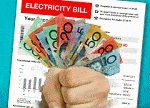Many Australians may be waiting for electricity prices to magically plummet under an Abbott-led government – but it might not happen. If it does; it could be quite short lived.
When considering today’s electricity prices, it’s important to understand their composition and what drives price rises. In the lead-up to the recent election (and since), electricity price issues were (and continue to be) often distorted.
Retail costs
This includes customer acquisition and retention, billing, meter reading, customer support etc. and makes up around 9% of a bill.
Carbon tax
Around 9% – but while the carbon tax was a convenient scapegoat in election battle cries, households receive on average $10.10 per week in assistance to help cover its impact, which in relation to electricity is around $3.30 per week (Source: RET.gov.au – PDF).
Green schemes overall
Including other green schemes such as the Renewable Energy Target and various energy efficiency initiatives – and not taking into account the relief provided by the household assistance package – the total impact of all green schemes is around 20% of an electricity bill.
The cost of green schemes would have continued to decrease without further intervention; while providing increasing benefits in terms of zero-carbon and often decentralised power generation.
Wholesale cost of electricity
The wholesale cost of electricity makes up around 20 per cent of a power bill. The price of wholesale electricity has been reined in during recent years, thanks in part to home solar power.
Earlier this year, it was estimated between $300 million and $670 million is being saved on wholesale electricity costs due to the million-plus households who have installed solar panels. Why those savings haven’t been passed on is for the owners of the generators to answer; which in some cases are state governments.
Network charges
These are the charges associated with the poles and wires and other infrastructure that deliver electricity. These charges account for about 51 per cent of a power bill.
It’s been proven time and again that network charges are the major culprit in electricity price rises. Again, some of the beneficiaries are state governments; such as in the case of Queensland where networks are state owned.
Short-sighted = more expensive electricity
Even if the slash and burn of some renewables programs and the renewed love affair with fossil fuels that Australia appears to be about to embark on under an Abbot-led government does result in lower electricity prices, it could well be short lived.
Cheaper electricity from fossil fuel sources is all about large scale centralised generation. Cheaper electricity will invariably lead to increased consumption of this carbon intensive electricity. This will result in even more needing to be spent on infrastructure to cope with the resulting demand; which in turn will add to the “poles and wires” charges, pushing prices back up again.
The only real way to restrain and even bring down power prices is to encourage uptake of small-scale solar power systemsand other renewables; not kneecap them and to continue like lemmings to chase fossil fuel based power generation.
Australia is blessed with so many renewable energy resources that could be providing us with cheap and clean power with the proper policies and support – it would be a shame to see it devolve into a renewable energy backwater instead of the world leader it could be.












































